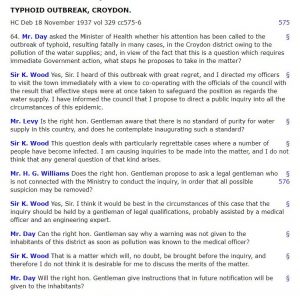We take for granted a clean, safe water supply. Infected and polluted water can kill. This was the crux of the account of the typhoid epidemic in Croydon, the outbreak first recorded on 27th October 1937 resulting in 43 deaths and 341 contracting the bacteria. Symptoms include extreme lucidity, delusion, intense fever, loss of appetite, insomnia and a rose pink rash with spots.

Positive proof of the origin of the outbreak was not given, but the conclusion was that it was caused by polluted water from a chalk well in Addington, a suburb of Croydon, from which water was supplied to between 36,000 and 40,000 inhabitants. The well, 10 feet in diameter and 250 feet deep, was built in 1888. Essential maintenance work was needed on the pumps, filters and brickwork. From the beginning of the work until 15th October the water was pumped to waste but thereafter, until 3rd November, it was pumped to supply. The repairs were carried out by 18 volunteers who were sewer workers with no experience of water supply. The men were lowered into the well on a platform which also served to transport tools, materials and rubble. To cater for their ‘calls of nature’ a bucket was lowered and raised to the surface on the platform for urine disposal and they were instructed to come to the surface for ‘bowel movements.’ Clearly, the men were trusted to obey these simple instructions. Subsequently, it was discovered that one of the workers was a carrier of the typhoid bacteria.
At the top level enquiry led by Mr H.L. Murphy, all workers stated on oath that they followed the correct procedures for disposing of urine and faeces, and did not pollute the water supply. Filters and chlorinators play a major role in the purification of water. The filters, eight feet in diameter, were removed for cleaning and maintenance, with the unintended consequence that the chlorinators did not function. The water supply was neither filtered nor chlorinated.
The enquiry under Mr Murphy looked at the roles of senior management and in particular the Borough Engineer and the Medical Officer for Health for Croydon. It found that the remit of the Borough Engineer was too wide for one person and responsibility for water was only one of his many important duties. The Medical Officer believed food was more of a health hazard than water. It appeared that these two officers had little or no contact or communication with each other. It was no wonder the water supply was neglected, resulting in no procedures or documentation for water samples, chlorination and the general quality of the water supply.

The enquiry concluded that the infection was caused by a combination of factors coming together, namely that the well was under repair, that one of the workers was a typhoid carrier and that the supply water was not chlorinated. Management was implicated and criticised for not sufficiently managing the water supply and for not having adequate communications and backup procedures and records. This was a major turning point in the governance of the water industry, with the introduction of codes of practice resulting from a High Court case. Croydon was a major incident in the water industry with fatalities proving to be a formative event in making the public and authorities aware of the critical importance of a clean and safe water supply. It was a most interesting talk which prompted many questions from our members.
